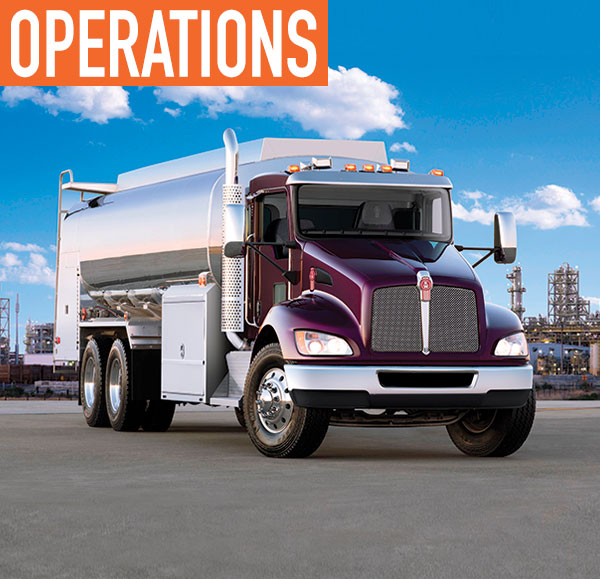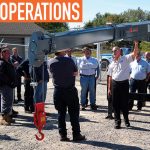Truck manufacturers, like Kenworth, are working to make it simpler for customers who want heavy-duty characteristics in traditional medium-duty applications, including construction, refuse, liquid bulk, food and beverage distribution, snowplows and highway maintenance, and fire and rescue.
Companies that operate medium-duty trucks seek a business solution that provides superior uptime, reliability, and dependability. “These three factors are especially important in their truck choices. Day-in and day-out, medium-duty trucks are work trucks that must make timely deliveries, pick-ups, or service calls in order to satisfy their customers,” says Kurt Swihart, Kenworth marketing director.
“The challenge in spec’ing a medium-duty truck is to find the right balance—between over and under spec’ing—to achieve the performance and reliability required to get the job done on a daily basis,” Swihart notes.
Below, Swihart outlines five things you should know about spec’ing a medium-duty truck for heavier weights and tough applications.
MORE HORSEPOWER AND TORQUE RATINGS
With today’s engine technology and electronic controls, a 9-liter diesel can produce a range of horsepower and torque ratings for applications that fall in between typical medium-duty and heavy-duty use.
“The more choices of engine ratings we can offer, the easier it is to customize and fine-tune the customer’s power needs,” Swihart says.
For instance, the PACCAR PX-9 has ratings from 260 to 380 hp and up to 1,250 lb-ft of torque. Features like replaceable wet liners, roller cam followers, bypass oil filtration, and targeted piston-cooling are decidedly heavy-duty, yet the engine’s displacement and weight are ideal for the Kenworth T370, T440, and T470 trucks, which can be spec’d as a light Class 8 or a heavier-duty Class 7.
At the same time, Swihart cautions not to spec more power than you need.
“Look at our Kenworth T370. Under most circumstances, the PACCAR PX-7 engine delivers plenty of power and torque for a Class 7 truck,” he says. “It produces 200 to 325 hp with up to 750 lb-ft of torque from a 6.7-liter displacement, an excellent horsepower-to-weight ratio. With a bigger engine you’d start trading off fuel economy and weight.”
HIGHER-CAPACITY FRONT AXLES
A lighter engine and higher-capacity front axle give you the ability to shift more weight to the front end and still have all the advantages of a short bumper-to-back-of-cab (BBC) measurement.
“We offer 18,000-lb and 20,000-lb front axles on Kenworth T370s equipped with a PACCAR PX-9 engine, a response to bulk fuel distributors, construction, refuse, dump truck operators, and other customers who not only want a true medium-duty truck, but also the ability to distribute the weight of payload to the steer axle,” Swihart says.
The heavier axle package comes with a heavy-duty, cross-brace-reinforced front frame assembly, bolted cross members, and either 10¾-inch frame rails or 10⁵⁄₈-inch frame rails with inserts. Iron hubs, drum brakes, and dual-power steering gears, along with a power steering cooler, are part of the spec.
OPERATOR-FRIENDLY TRANSMISSIONS
Automatic and automated transmissions allow fleets to hit the “sweet spot” in terms of drivability and fuel economy.
One example, Swihart says, is the 10-speed Eaton UltraShift® PLUS, a two-pedal solution for Kenworth medium-duty trucks that dramatically widens the driver pool and reduces training costs. Eaton UltraShift PLUS has an electronic clutch actuation system that enables quick shifts and clutch engagement regardless of engine rpm. It selects the right start gear and adapts shift decisions based on the driving environment, so you get smooth, automated shifting and vehicle launches.
Automatic transmissions continue to evolve and grow in popularity in the medium-duty segment. Allison’s FuelSense™ feature has electronic controls that automatically adapt shift schedules and torque, maximizing transmission efficiency based on load, grade, and duty cycle. “We offer a multitude of FuelSense options to best suit each customer’s needs, either for greater performance or for a fuel economy focus,” says Swihart.

Featured Image: Companies that operate medium-duty trucks seek a business solution that provides superior uptime, reliability, and dependability.
Above: A lighter engine and higher-capacity front axle give you the ability to shift more weight to the front end and still have all the advantages of a short BBC measurement.
CUSTOMIZED APPROACH
The truck dealer, body builder, and truck OEM have exceptional resources available to help you customize your spec, so your vehicle is set up exactly the way you want it and is productive from the start.
“When you’re looking at truck and body suppliers, ask how the two communicate,” Swihart says. “Are they talking to one another and sharing ideas on a steady basis to make sure that the chassis and body come together as expected?”
A generation ago this process involved drawings and body-builder manuals being sent across the country with fingers crossed that there were no mistakes or missed connections to delay the process. “Today, we’re sharing 3D CAD models that show crossmember locations, PTO locations and clearances, special frame drilling patterns, and other air, electrical, and emissions equipment on the frame,” Swihart says.
If you want to see what your chassis would look like with a horizontal crossover DPF with a ground-dump tailpipe and compare it to a DPF under the right-hand side of the cab with dual tailpipes, it can be done on the screen. “As a customer, you can visualize what your truck is going to look like right down to a fine level of detail before anyone drills the first hole,” Swihart says.
LOWER TOTAL COST OF OWNERSHIP
The biggest misconception about the medium-duty truck market is that you have to limit your choices or settle for a truck that’s not exactly what you need because price is an issue, Swihart explains.
“Let’s face it, this is a price-conscious market,” he says. “But price is only one factor in the total cost of ownership. The lower-priced truck may be more expensive to operate over time compared to a truck that costs more at the outset, but is more durable, reliable, and better suited to the task at hand. The low-priced truck probably won’t hold its resale value, either.”
Swihart’s advice to medium-duty truck owners: Focus on the total lifecycle cost of the vehicle. He says Kenworth dealers can help you calculate a truck’s total cost of ownership, from the initial acquisition until it’s time to trade the vehicle in for a new one.
FOR MORE INFORMATION:
Kenworth Truck Company—a PACCAR company—is the manufacturer of
The World’s Best® heavy- and medium-duty trucks. Find out more about Kenworth’s products and services, visit www.kenworth.com.
_______________________________________________________________________
MODERN WORKTRUCK SOLUTIONS: FEBRUARY 2016 ISSUE
Did you enjoy this article?
Subscribe to the FREE Digital Edition of Modern WorkTruck Solutions magazine.
![]()




